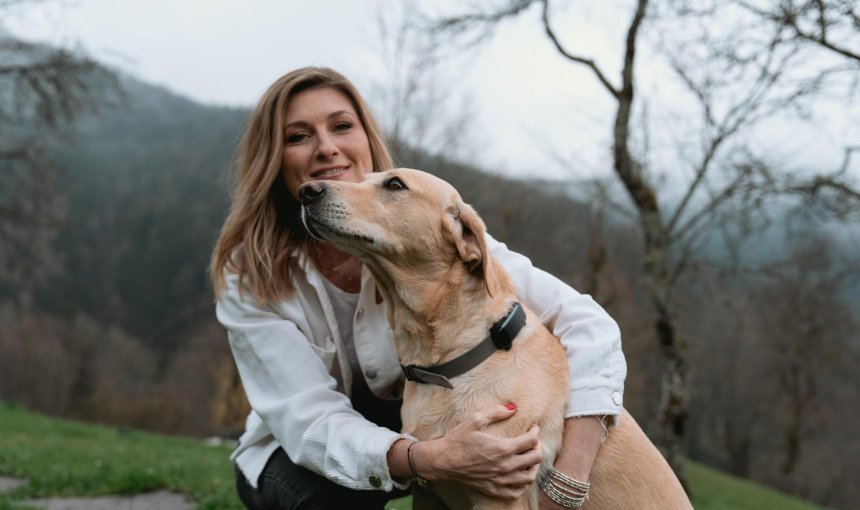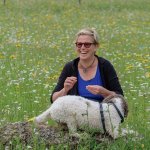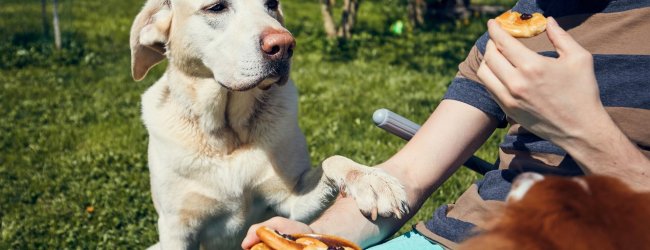Why Is My Dog Scared Of Everything? Our Expert’s Take
Here's how to handle them in panic mode & prevent a runaway attempt or other destructive behavior.

Just like humans, dogs can be fearful, shy and anxious (especially if you’ve adopted a shelter dog). But if you’ve reached here, you might’ve been asking yourself: why is my dog scared of everything? In this post, we’re going to cover some of the signs your buddy suffers from a heightened fear response – including some tips, tricks, and best practices from our resident dog expert, Bettina Neuner. (And why she recommends tracking your scaredy-dog’s every step in real-time.)

Always know your buddy is healthy & safe
Read moreWhy is my dog scared of everything?
If you’re finding yourself dealing with a dog that’s scared of…well, everything – there’s definitely more to it than just them being a “scaredy-dog.” Usually, your dog might get scared or nervous around:
- Loud noises – including fireworks
- Storms
- Fire
- Unfamiliar people and places
- Other dogs (or pets)
- Specific environments, like the vet’s clinic or boarding kennels
…all of which could have some lingering unpleasant association or memory.
But if your dog seems to have an exaggerated fear response, eventually, this might interfere with their quality of life – including yours. Just imagine never being able to socialize your dog properly because they’re too scared of the dog park or try to run away every time you bring them to the vet for a checkup?
Read more: Why Do Dogs Run Away? 6 Reasons Behind It
The telltale signs of a scared dog
In general, dogs tend to show these signs when scared – but usually calm down after, once the “scary” experience is over:
- Shaking or pacing
- Growling, barking, whining, howling, or excessive panting
- Wide, open eyes and dilated pupils
- Tail tucked between legs
- Head turned away from the cause of fear
- Ears facing sideways/backwards
- Attempting to “escape” a room or cage to the point of self-injury
- Crouching, slinking, or moving backwards
- Hiding
But if you’re finding your dog continuing to be “scared”, say, even after the experience (like once you’re back home from the vet’s or the other, rambunctious dogs at the park are far away) – it could be a sign of deeper anxiety or trauma. Falling for their “flight” instinct is usually a primary reason why a scared dog might end up running away – too far from safety.
💡A dog GPS tracker can be a potential lifesaver in cases of a runaway dog. Just switch to LIVE tracking via your Tractive mobile app – and follow their every step in real-time.

Follow your dog anywhere
Get real-time location information, wherever they go. And find out when they try to make an escape, or just when they go somewhere they shouldn’t, with Virtual Fences.
The 4 F’s of Fear
In general, it also helps to be aware of the 4 F’s of Fear – all behaviors you might observe in a scared dog:
- Freezing
- Fleeing
- Fighting
- Fooling around
By learning to identify these patterns in your dog’s behavior, you can more quickly tell if they’re frightened (and about to hide or run away) and take the necessary steps to comfort them.
Should you punish a dog that’s aggressive out of nervousness?
Fear is a major cause of aggression in dogs – usually as a defensive, not offensive, reaction. Which is why no, it’s never a good idea to punish a dog in these situation as behaving “badly.” Punishing dogs for fear-based aggression will only make the dog more fearful and aggressive than they were before the punishment. Of course, correcting a dog’s behavior is important when he or she become aggressive. But punishment is not always the proper method of dealing with it. (Especially if you have a fearful dog on your hands.)
💡Rather, you’re better off pre-empting what’s spooking (or about to spook) your dog. Ensure they’re in a safe and comfortable environment and keep an eye on their body language. (Look at this little guy’s dilated pupils and nervous posture, for example.)
What to do if your dog panics
Panic attacks are a symptom of anxiety disorders which usually occur suddenly and without warning. There are no specific triggers, so it’s quite unpredictable. A dog panic attack normally lasts about 30 minutes.
During this time, we strongly advise you don’t approach the dog. All you can do is try to be near them and make sure that no one gets hurt by their fearful, and potentially aggressive, behavior. For example, if you touch a dog during a panic attack, they may snap and bite. Keeping your dog firmly leashed can help them feel more secure – especially since they’re close to you.
Next, speak softly to your dog and call them by name. The sound of your voice can help them calm down in the absence of touch. Try and understand what’s triggering your dog’s anxiety in the first place. By pre-empting what’s likely to spook your dog, you’ll be better able to set their environment up to prevent exposure. Or slowly desensitize them to the “scary” sounds or experience.
Next, set them up a safe indoor space – ideally in a quiet area of your home. Turning on the radio or a white noise machine can help calm them down. Or keep them occupied with a YouTube “dog TV” video.
How to counter-condition your dog against “scary” experiences
Like, for example, if they’re scared of thunder:
- Keep your dog busy with some fun activity, like playtime together.
- In the background, play the “scary” sound at a super low volume – like from a YouTube channel, for example. (Your dog’s sensitive ears will pick up on it, we promise you.)
- Very gradually, increase the volume of the sound while continuing to play with your dog.
- With regular practice, your dog might gradually learn not to spook so easily at the sound. (Since they’ve learned it’s “no big deal.”)
- Use the same steps to slowly, gently introduce your dog to whatever they’re frightened of. Whether that’s driving in your car, other dogs, or the sound of the vacuum cleaner.
Just remember: every dog and reaction is different. There really isn’t any one-size-fits-all solution. So you’ll have to do a little digging to find out what comforts your dog in moments of fear – and what doesn’t.
Your vet is also the right person to turn to. They can prescribe your dog anti-anxiety medication and help you explore your options in case you need the services of a certified animal behavioral expert.
What to do if your dog runs away
If your dog runs away due to fear, do the following right away:
- Inform your vet, the police, the local animal shelters and your neighbors.
- Inform the national pet register (where your pet is registered).
- Leave the garden and house doors open in case your dog manages to come back themselves.
- Consider making a Facebook post. Inform your friends and family that your dog is lost so that they can also share it with members of the wider community.
Read more: 9 Steps To Find A Lost Dog & Bring Them Home In No Time
Approaching a scared lost dog
If someone else locates your dog, they should do their best to avoid scaring them further. Or even trying to catch them. Instead, they should contact you so that only you (the trusted owner of the dog) can approach and retrieve him. Whether you are helping someone to find a lost dog, trying to calm a scared dog, or just trying to approach an animal on the street to offer it assistance, knowing the signs of a frightened dog and how to approach it safely can make a world of difference.
Preventing your dog from running away
Despite all of our precautions, it is still possible that a scared dog could escape from the house. Or without knowing better, run away from his or her parents. Even with a leash, safety harness and training, you can’t be 100% sure that your dog won’t escape. For that reason, a GPS tracker can be an important – and life-saving – emergency measure for dogs that are prone to fear and anxiety attacks. With one, you can find your dog quickly and prevent them from coming into harm’s way. (With just a glance at your phone.)
💡Your trusty Tractive GPS also comes equipped with a built-in Bark Monitor. This picks up on your dog’s normal barking patterns and alerting you if it’s excessive or accompanied with other signs of anxiety, like restless pacing.

So you can check in with your dog via the petcam or get someone to check in on them. (Or even head home for a quick cuddle.)
“This device has made my dog’s life so much better and given me incredible peace of mind. She is a Husky mix with lots of adventure in her and we live in the country. She loves to roam freely, but if she hears a hint of thunder, she gets scared and has run to the road.
Now I get alerts and know when she is headed the wrong direction if the weather changes suddenly. The accuracy is incredible. As the owner of a dog training business, Kinder K9, I love to promote this product to my clients!”
– Lisa Buchanan, CA (Source: Trustpilot)

Bettina Neuner is an animal welfare-qualified dog trainer and nutritionist based in Tirol, Austria.
She offers advice and individual training for dogs, including coaching for fearful dogs and their parents. Check out her website at hundeschule-tirol.at.




